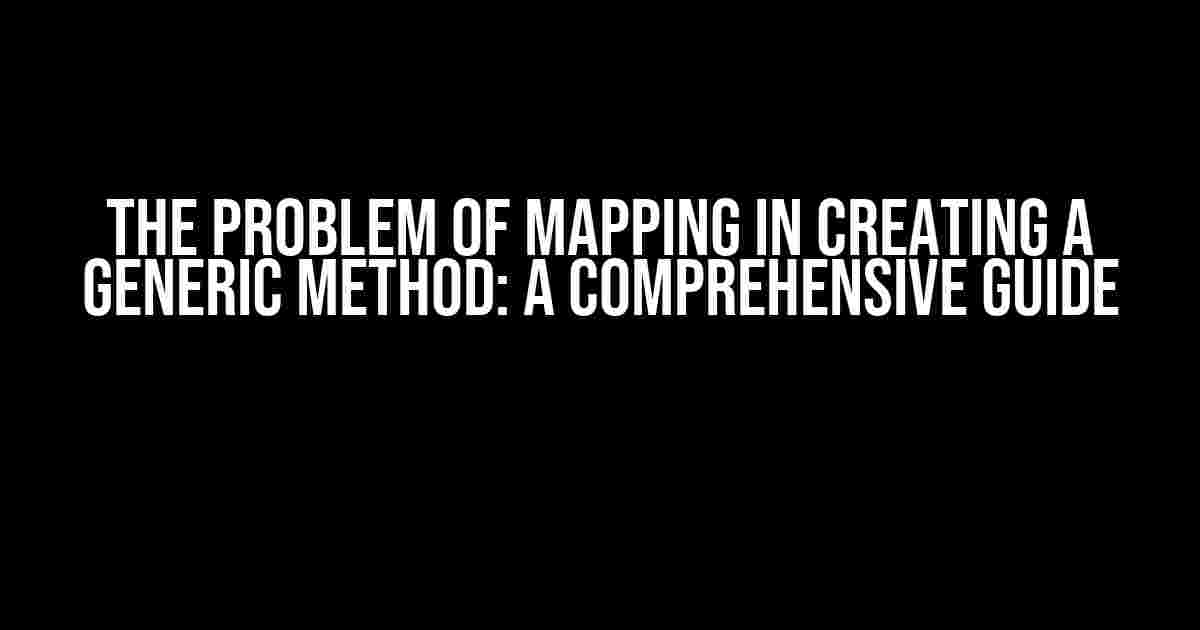Creating a generic method can be a daunting task, especially when it comes to mapping. In this article, we will delve into the world of generic methods and explore the problems of mapping that arise during their creation. We will provide clear and direct instructions on how to navigate these challenges and create a robust generic method that meets your needs.
What is a Generic Method?
A generic method is a method that can work with multiple data types, allowing for greater flexibility and reusability. This is achieved through the use of type parameters, which enable the method to adapt to different data types. Generic methods are essential in today’s software development landscape, where versatility and adaptability are key.
The Problem of Mapping
One of the most significant challenges in creating a generic method is mapping. Mapping refers to the process of converting one data type to another. In the context of generic methods, mapping becomes complex due to the need to accommodate multiple data types. This complexity can lead to errors, inconsistencies, and performance issues if not addressed properly.
Types of Mapping
There are two primary types of mapping: implicit and explicit mapping.
- Implicit Mapping: Implicit mapping occurs when the compiler automatically converts one data type to another. This type of mapping is often used in languages that support implicit type conversion, such as JavaScript.
- Explicit Mapping: Explicit mapping requires manual conversion of one data type to another using explicit cast or conversion methods. This type of mapping provides more control over the conversion process but can be error-prone if not implemented correctly.
Challenges of Mapping in Generic Methods
When creating a generic method, mapping becomes even more complex due to the following challenges:
- Type Erasure: In languages that support generics, type erasure occurs at compile-time, which means that the actual type information is lost. This makes it challenging to perform mapping, as the type information is not available at runtime.
- Type Inference: Type inference is the process of automatically determining the type of a variable or expression. In generic methods, type inference can be problematic, as it may lead to incorrect type assumptions and mapping errors.
- Multiple Inheritance: Generic methods that use multiple inheritance can lead to the diamond problem, where a class inherits conflicting members from its parent classes. This can result in mapping errors and inconsistencies.
How to Overcome the Challenges of Mapping
To overcome the challenges of mapping in generic methods, follow these best practices:
| Challenge | Solution |
|---|---|
| Type Erasure | Use explicit type casting and conversion methods to ensure correct mapping. |
| Type Inference | Use explicit type annotations to avoid type inference errors. |
| Multiple Inheritance | Use interfaces or abstract classes to avoid the diamond problem and ensure correct mapping. |
Example: Creating a Generic Method with Mapping
Let’s create a generic method that takes a list of integers and converts it to a list of strings. We will use explicit type casting and conversion methods to ensure correct mapping.
<code>
public static List<string> ConvertToIntegers(List<int> integers)
{
List<string> strings = new List<string>();
foreach (int integer in integers)
{
strings.Add(integer.ToString());
}
return strings;
}
</code>
In this example, we use the ToString() method to perform explicit mapping from integers to strings. This ensures correct mapping and avoids type erasure issues.
Conclusion
Creating a generic method with mapping requires careful consideration of the challenges involved. By understanding the types of mapping, challenges, and best practices, you can create a robust and adaptable generic method that meets your needs. Remember to use explicit type casting and conversion methods, avoid type inference errors, and use interfaces or abstract classes to avoid multiple inheritance issues. With these guidelines, you can overcome the problem of mapping in creating a generic method and write efficient, reusable code.
By following these instructions and explanations, you will be well on your way to creating a generic method that is both flexible and reliable. Happy coding!
Here are the 5 Questions and Answers about “The problem of mapping in creating a Generic Method”:
Frequently Asked Question
When creating a generic method, one of the common hurdles developers face is the problem of mapping. Get answers to the most frequently asked questions about this issue and learn how to overcome it!
What is the main reason behind the mapping problem in generic methods?
The main reason behind the mapping problem in generic methods is the lack of constraints on type parameters, making it difficult to map the types correctly. This leads to ambiguity and errors in the method implementation.
How does the use of raw types contribute to the mapping problem?
Using raw types (i.e., not using generics) can lead to the mapping problem because the compiler is unable to perform type checking, making it difficult to determine the correct type mapping. This can result in ClassCastException at runtime.
What role does type erasure play in the mapping problem?
Type erasure, a process in which the compiler removes generic type information, can contribute to the mapping problem. During runtime, the type information is lost, making it challenging to perform correct type mapping.
How can I avoid the mapping problem when creating a generic method?
To avoid the mapping problem, use bounded type parameters, specify type constraints, and avoid using raw types. Additionally, consider using adapter classes or interfaces to help with type mapping.
What are some best practices to keep in mind when mapping types in a generic method?
Some best practices to keep in mind include using meaningful type parameter names, documenting type constraints, and testing your method with various input types to ensure correct mapping.
